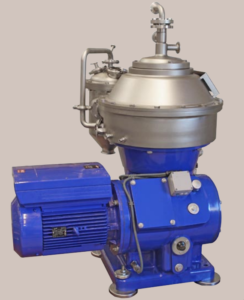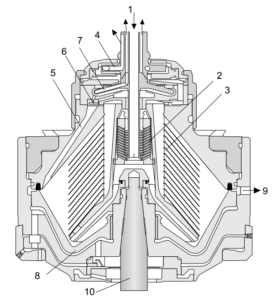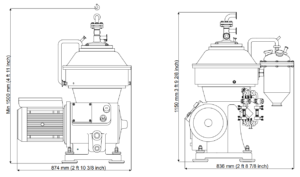Home » Separators » Alfa Laval Separators »
Alfa Laval BTUX 305 Separator
The key to success in bridging the gap from the laboratory to commercial production is a pilot plant that delivers result that will be relevant when moving into full-scale production. Scaling up involves compromises that often cannot be predicted in the laboratory. One rule in scale-up is to use the same type of centrifuge equipment on the small scale as is foreseen for the large scale production. Therefore, Alfa Laval has developed the BTUX 305TGD-34CDEP to facilitate scale-up to production size centrifuges of the same type, i.e. nozzle centrifuges with pressurized concentrate outlet, employed mainly for yeast and bacteria separation. The BTUX 305 is suitable for feed rates up to 2,500 l/h. Its system for Cleaning-in-Place (CIP) includes an intermittently operated, peripherally discharging system.
For biological hazards the system round the centrifuge can be designed for steam sterilization and contained operation, meeting the requirements of the NIH guidelines for BLS 2. Furthermore, Alfa Laval experience in hygienic equipment design and GMP manufacturing ensures the integrity of valuable biopharmaceuticals.
Applications
The machine is designed for clarification duty, separating particles from one liquid, especially shear sensitive particles. The sterilizability makes the machine suitable for most biotechnological separation duties. The solids content in the feed is normally in the range of 1–20 % by volume, but can vary between different duties.
Standard design
The machine consists of a frame that has a horizontal drive shaft, worm gear, lubricating oil bath and a vertical bowl spindle in the lower part. The bowl is mounted on top of the spindle, inside the space (bowl casing) formed by the upper part of the frame, the solids collecting cover and the frame hood. The bowl casing is double-walled for cooling and noise reduction. There is a mechanical seal at the top of the spindle to make sterilization with steam possible. For continuous pressurized discharge of separated solids the machine is fitted with a non-rotating device, a paring tube, positioned inside a central chamber, to which the separated solids flows through vortex nozzles.
All metal parts in contact with the process liquid are made of stainless steel. For CIP, the bowl contains an automated hydraulic operating system for discharging. It is a system, in which the bowl content is emptied in connection with an automated CIP procedure. The discharge takes place at full speed without any interruption of feed of CIP liquids. The centrifuge is available with main connections as sanitary clamps and all other utility connections of clamp type. The electric motor is suitable for variable frequency drive, which makes it possible to have bowl speeds down to 62% of the maximum bowl speed. The design conforms to a number of EC directives, and the machine is made in accordance with the general directives for machinery. The machine is equipped with nozzles for flushing of the bowl top, the bowl bottom and the solids collecting chute.
Design features
- Self regulating vortex nozzles keeping the concentration of the discharged solids at a high and even level, making it possible to operate more near to the clogging point without increased risk of clogging.
- Two outlet designs available for different flow ranges.
- Disc inlet for gentle acceleration of the feed.
- Designed for easy cleaning-in-place (CIP) with an intermittently operating peripheral discharge solids-ejecting system.
- Design pressure of the bowl casing 300 kPa.
- Bowl casing and cooling jacket designed according to ASME or PED.
- Sterilizable (SIP) with 190 kPa steam during 30 mins, including discharge system.
- Most parts in contact with the process liquids available with two alternative surface finishes.
- Product wetted parts passivated (optional).
- All product wetted polymers and seal rings compliant with FDA regulation.
Operating principle
The feed is introduced to the rotating centrifuge bowl from the top (1), and is accelerated in a distributor with disc inlet (2) before entering the disc stack (3). It is between the discs that the separation takes place. The liquid phase moves towards the centre of the bowl, from where it is pumped out under pressure by means of a built-in pump disc (4). The heavier solids phase (concentrate) is collected at the bowl periphery, and from there it flows through channels (5) and internal vortex nozzles (6) into the paring tube chamber, where the concentrate is skimmed off by the paring tube (7) and discharged under pressure. The bowl can be opened intermittently during production and/or the CIP cleaning cycle for ejection of solids while the machine continues to run at full speed. During normal production operating water keeps the sliding bowl bottom (8) closed against the bowl hood. During discharge the sliding bowl bottom is forced to drop down, thus opening the solids ports (9) at the bowl periphery. The bowl is mounted on a vertical spindle (10) driven by a horizontally mounted motor, via a worm gear.
Utilities principle
| Electric power | max. 6.5 kW |
| Flushing liquid per discharge | up to 10 l per discharge |
| Operating liquid for CIP | 0.2–0.35 l per discharge |
| Steam @ 100 kPa pressure | 5–10 kg per sterilization |
| Cooling liquid for frame parts | 100–700 l/h |
| Cooling water for seals | 60–300 l/h |
Dimensions

Technical specifications
| Throughput capacity | max. 2,500 l/h |
| Solids handling capacity (nozzle flow rate) | max. 800 l/h |
| Bowl volume | 3.1 liters |
| Sludge space volume | max. 1.1 liters |
| Discharge volume | 0.80–1.2 l |
| Bowl speed, separation | 6,000–9,650 rpm |
| Bowl speed, sterilization | 0 rpm |
| G-force | max. 12,750 |
| Motor speed | max. 3,000 rpm |
| Motor power installed | 7.5 kW |
| Starting time min/max | 3 mins |
| Stopping time with motor brake | 8 mins |
| Feed temperature range | 0–100°C |
| Feed inlet pressure required at inlet flange | max.10 kPa |
| Liquid outlet pressure at outlet flange | max. 400 kPa |
| Sound pressure | 77 dB |
| Overhead hoist lifting capacity | min. 100 kg |
